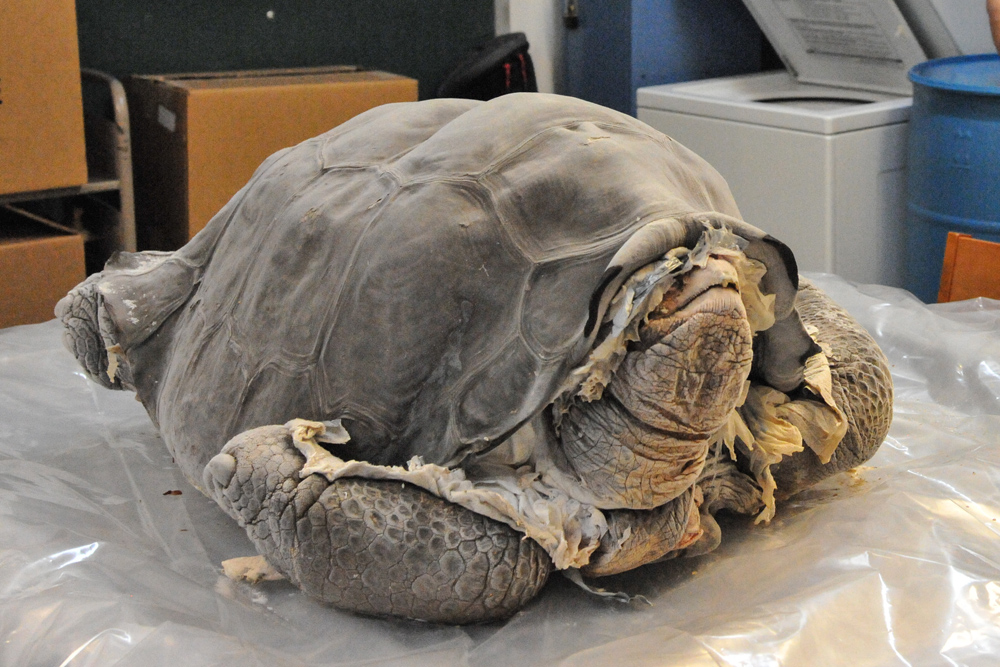Lonesome No More: George the Giant Tortoise on Public Display in NYC

NEW YORK — With head held high outside of his enormous shell, the giant tortoise proudly looks out from his rock-strewn box at the American Museum of Natural History (AMNH) in New York City. Just as in life, the painstakingly preserved reptile appears to extend his neck for a better view of his surroundings.
The creature on display is none other than Lonesome George, once known as one of the rarest creatures in the world. The last known giant tortoise from the island of Pinta in the Galápagos archipelago, George died of old age in June 2012 after what scientists say was about 100 years on Earth.
For the past two years, taxidermy experts have worked tirelessly with scientists at AMNH to preserve Lonesome George for future generations. And that team of professionals has done an impressive job.
The world-famous tortoise, which will be displayed at the museum from Sept. 19 to Jan. 4, 2015, seems to appear just as he did in life, right down to a missing toenail on his left front foot. [See Images of Lonesome George in Life and Death]
"Even getting the eye color right was an incredibly complicated effort," said Christopher Raxworthy, curator of the museum's Department of Herpetology. While George was arguably the best-documented giant tortoise that ever lived, scientists never captured up-close images of the animal's eyes, which meant that Raxworthy and his team had to do some investigating to get the color just right, the curator said.
The team even went as far as to replicate the green stains that had been present on George's throat after his last meal. Without those subtle imperfections, George just didn't look like himself, Raxworthy told reporters yesterday afternoon (Sept. 18) at a press event to commemorate Lonesome George's public debut.
After his death at the Charles Darwin Research Station on Santa Cruz Island in the Galápagos, George was frozen, packed and shipped to the United States. The 5-foot-long (1.5 meters), 165-pound (75 kilograms) tortoise arrived in good condition, museum curators said.
Get the world’s most fascinating discoveries delivered straight to your inbox.
It was then up to taxidermists and museum scientists to decide exactly how they wanted to preserve Lonesome George for posterity.
"What posture should a tortoise have? We wanted something that would really capture the majesty of George," Raxworthy said. They opted for a pose that would bring the famous reptile out of his shell.
George's saddleback shell, which is curved up at the end nearest the animal's head, allowed him to fully extend his neck to graze vegetation out of reach, according to the curator. This ability to stretch so far out of his shell also came in handy when George needed to intimidate other males, according to Raxworthy.
It seems fitting that this signature, long-necked pose is the one taxidermists used when preserving George. And as a result of this decision, the giant tortoise you'll find at the exhibit is almost haughty in appearance. While his posturing might not intimidate humans as it once did other tortoises, George's presence does inspire a certain feeling of awe, which is likely exactly what museum curators intended.
In his time on Earth, George served as a poster child for what human beings can lose if they don't make the effort to conserve vulnerable species. For museum scientists, as well as the many organizations that participated in getting George to the museum and restoring him to his lifelike appearance, this preserved tortoise seems to serve as both a reminder and a warning.
"We have a responsibility as stewards to the environment," said Eleanor Sterling, chief conservation scientist of the museum's Center for Biodiversity and Conservation, at the press event. "Lonesome George's story, both in life and in death, serves as a catalyst for widespread discussion of — and support for — conservation efforts in the Galápagos and beyond."
After his brief stay in New York, Lonesome George will return to the Charles Darwin Research Station in the Galápagos, which was his home for 40 years.
Follow Elizabeth Palermo @techEpalermo. Follow Live Science @livescience, Facebook & Google+. Original article on Live Science.



